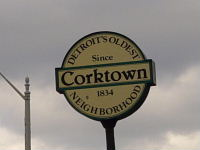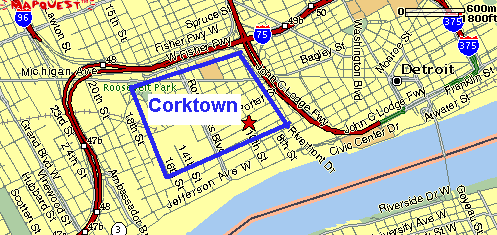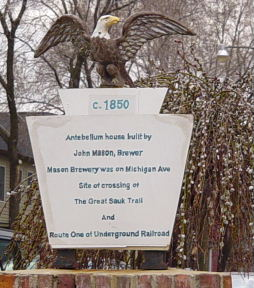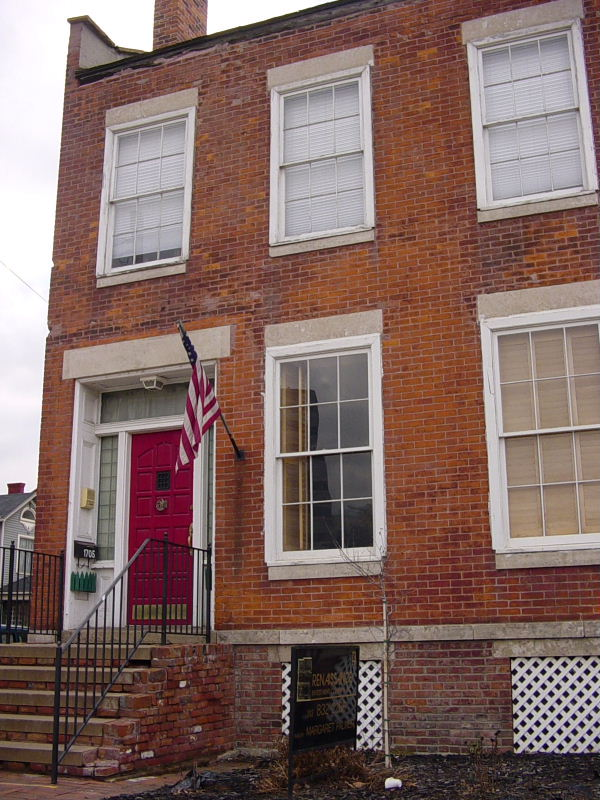 |
by: Korin Cox |
 |
by: Korin Cox |
The Corktown neighborhood is Detroit's oldest surviving neighborhood. The surviving residential fragment is listed on the National Register of Historic Places and is designated as a City of Detroit Historic District. The district includes about 300 structures housing about 2,000 people.
WHERE IS CORKTOWN?
The Corktown
Historic District is located directly south of Michigan Avenue, and directly
west of Lodge Freeway (US 10). The buildings of the Corktown Historic District
are largely private residences, although some Michigan Avenue commercial
buildings are open to the public.

Most Holy Trinity Church (1)
Corktown's oldest house (2)
new
townhouses (3)
Labrosse Street (4), most intact block of Detroit's oldest
houses (4)
Clement Kern Gardens (5)
Bagley-Trumbull Market (6)
St.
Peter's Episcopal Church (7)
Tiger Stadium (8)
Roman brick rowhouse
group (9)
1705 Sixth Street (10)
ORIGINS OF THE NAME CORKTOWN
At
mid-century, the Irish were the largest ethnic group among Detroit's newcomers,
prompted by the Potato Famine in Ireland in the mid-1840's. The Irish moved into
the near West Side. Since many of these came from County Cork, their
neighborhood came to be known as "Corktown."
ARCHITECTURE OF HOUSES IN CORKTOWN
The
neighborhood was first known for the housing style - small Irish workman's
cottages. Houses in Corktown are typically built close to each other on
narrow 25-foot lots extending perhaps 130 feet from front sidewalk to back
alley. This is a land pattern dating back to the London of King Charles II over
300 years ago.
Leverette Rowhouses in
the Corktown Historical District
TRANSPORTATION IN CORKTOWN
Our first
horse-drawn trolley cars appeared on Michigan Avenue in November 1863. More
important to Corktown was the Baker Street Trolley line, opened in 1873. It
passed along Bagley Avenue (originally "Baker Street" in Corktown).
Horse-drawn street car
TIGER STADIUM
Whether the name was
Navin Field to Tiger Stadium, the building and it's team - The Detroit Tigers
have been a defining feature of Corktown and the city surrounding it.
Although the stadium now sits empty of a major league team, Corktown has
survived.
View of Tiger Stadium from Michigan
and Trumbull
MICHIGAN CENTRAL STATION
The vacant
Michigan Central Station waits impatiantly along the slowly reviving Michigan
Avenue in Corktown. The station, closed since 1988, has been slowly
deteriorating ever since.
Michigan Central Station on
Michigan Avenue
OTHER INTERESTING VIEWS FROM CORKTOWN
favorite local pub and rock venue
The Lager House on Michigan Avenue


this house was built c. 1850 by John Mason -
site of the Great Sauk Trail and Route One of Underground Railroad

old Coca Cola ad on the side of this
building on Bagley Ave.

Corktown Tavern in the shadows of
the old Tiger Stadium

some local Irish Pubs on Michigan
Avenue

one of the many "Corktown" signs in
the area

the CPA building on Michigan Ave. -
now vacant

an old Lounge

the Gaelic League - Irish American
Club
CORKTOWN TODAY:
Corktown suffered in
the 1950s and 60s, however, when "urban renewal", highway construction, and
business district encroachment swallowed up or flattened dozens of blocks. Today
the homes, businesses, and churches that form the Corktown Historic District
offer a glimpse of the lives of generations of immigrants who helped build
Detroit.
Active Neighborhood groups:
THE CORKTOWN CITIZENS DISTRICT COUNCIL
project..corktowndetroit.org/
The Corktown CDC acts as a liaison between
Corktown, the oldest neighborhood in Detroit, and the City government by
representing community views on zoning issues, historic preservation, and other
development issues.
DETROIT HISTORIC NEIGHBORHOODS COALITION
project..neighborhoodlink.com/org/dethistoric
The DHNC is a collaborative
group of Detroit's historic neighborhoods. They focus on improving city services
such as police protection, lighting, garbage pickup, school clean up, &
more.
GRAFFITI-FREE COLLABORATIVE
This group promoting a "clean and safe"
message in Southwest Detroit is working very hard. More than 75 graffiti sites
have been successfully painted over or power-washed. They work with the
help the community to eliminate graffiti and build a graffiti-free ethic among
businesses, residents and youth to improve the quality of life and encourage
investment in Southwest Detroit.
WORKERS ROWHOUSE MUSEUM
An Oral History Project is underway to
assemble information about the people who lived in Corktown. The Workers Row
House Museum is said to be the oldest house in Detroit. It is a fine example of
how laborers and workers lived from the 1840's-1960's. The restoration and
development of the project continues while the quest for "Corktown Memories" is
in progress.
Comments from the Press:
"Corktown afloat" in Metro Times
by Tricia Woolfenden
6/5/2002
Safety is a top priority in Corktown. “Everybody looks out for one another
here. The community helps each other, everyone gives a helping hand,” Formosa
says. His comments echo those of his neighbors and reflect the sense of security
that most Corktown inhabitants feel. Because Corktown is such a small area,
encompassing roughly one square mile, suspicious activity is quick to be
noticed; residents are even quicker to act upon it.
Rob McDonald, owner
of Eph McNally’s sandwich shop at the corner of Brooklyn and Porter, says that
safety was just one of the many factors that attracted him to the area 10 years
ago. “You have small businesses that don’t have bulletproof glass. It’s a
throwback to 40 or 50 years ago,” McDonald says. He also enjoys the crowd that
makes his shop a popular neighborhood hangout, from artists to police officers
to the White Stripes.
Corktown continues to move forward, while simultaneously holding on to the
past. The quiet streets lined with renovated Victorian-style houses seem as
though they belong in small-town U.S.A. rather than a major city such as
Detroit.
"Corktown lofts attracting renters to Detroit" in The Detroit News
by Christopher M. Singer 11/20/2002
Corktown, since the 1830s a neighborhood of conventional homes, has attracted new investment in loft developments. In the last few years five such buildings, some brand new, have opened in the area that comprises less than a square-mile west of downtown Detroit.
All this is great stuff as far as Tim McKay of the Greater Corktown Development Corp. is concerned. "The lofts have brought new interest in living in the city," McKay said. "It adds more people living downtown. It's a great reuse of buildings that would otherwise go unused." The development corporation recently moved in to the landmark CPA Building at Michigan at Vernor. McKay heads the Workers Rowhouse Museum project and the area's newly developed recycling center.
Special thanks to The Corktown Citizens District Council for their help!
Visit their website at project..corktowndetroit.org/
other people who love detroit and have wonderful pictures::
http://downtowndetroit.8k.com/
http://downtownmotown.8k.com